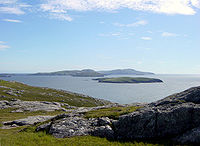
Pabbay, Barra, Scotland
Encyclopedia
Pabbay is one of the Barra Isles
at the southern tip of the Outer Hebrides
of Scotland
. The name comes from Papey, which is Norse for "Island of the papar
(Culdee
)" At only 250 hectare (0.965255396481338 sq mi), it never had a large population, and, after all the able-bodied men were killed in a fierce storm while out on a fishing trip on 1 May 1897, it was abandoned in the early twentieth century.
 The National Trust for Scotland
The National Trust for Scotland
have owned the island since 2000. With only two sheep left on the island (at July 2007) and few if any other permanent mammalian residents, Pabbay is home in summer to many ground-nesting birds.
The island was the site of a Celtic
hermit
age, and a Pictish
carved stone dates from that period. Remains of an Iron Age
settlement can also been seen on Pabbay.
The name of Pabbay is used for one of the three houses of Castlebay Secondary School. The other two are Mingulay and Sandray.
Barra Isles
The Barra Isles, also known as the Bishop's Isles as they were historically owned by the Bishop of the Isles, are a small archipelago of islands in the Outer Hebrides of Scotland. They lie south of the island of Barra, for which they are named. The group consists of nine islands, and numerous...
at the southern tip of the Outer Hebrides
Outer Hebrides
The Outer Hebrides also known as the Western Isles and the Long Island, is an island chain off the west coast of Scotland. The islands are geographically contiguous with Comhairle nan Eilean Siar, one of the 32 unitary council areas of Scotland...
of Scotland
Scotland
Scotland is a country that is part of the United Kingdom. Occupying the northern third of the island of Great Britain, it shares a border with England to the south and is bounded by the North Sea to the east, the Atlantic Ocean to the north and west, and the North Channel and Irish Sea to the...
. The name comes from Papey, which is Norse for "Island of the papar
Papar
The Papar were, according to early Icelandic historical sources, a group of Irish or Scottish monks resident in parts of Iceland at the time of the arrival of the Norsemen...
(Culdee
Culdee
Céli Dé or Culdees were originally members of ascetic Christian monastic and eremitical communities of Ireland, Scotland and England in the Middle Ages. The term is used of St. John the Apostle, of a missioner from abroad recorded in the Annals of the Four Masters at the year 806, and of Óengus...
)" At only 250 hectare (0.965255396481338 sq mi), it never had a large population, and, after all the able-bodied men were killed in a fierce storm while out on a fishing trip on 1 May 1897, it was abandoned in the early twentieth century.

National Trust for Scotland
The National Trust for Scotland for Places of Historic Interest or Natural Beauty, commonly known as the National Trust for Scotland describes itself as the conservation charity that protects and promotes Scotland's natural and cultural heritage for present and future generations to...
have owned the island since 2000. With only two sheep left on the island (at July 2007) and few if any other permanent mammalian residents, Pabbay is home in summer to many ground-nesting birds.
The island was the site of a Celtic
Celtic Christianity
Celtic Christianity or Insular Christianity refers broadly to certain features of Christianity that were common, or held to be common, across the Celtic-speaking world during the Early Middle Ages...
hermit
Hermit
A hermit is a person who lives, to some degree, in seclusion from society.In Christianity, the term was originally applied to a Christian who lives the eremitic life out of a religious conviction, namely the Desert Theology of the Old Testament .In the...
age, and a Pictish
Picts
The Picts were a group of Late Iron Age and Early Mediaeval people living in what is now eastern and northern Scotland. There is an association with the distribution of brochs, place names beginning 'Pit-', for instance Pitlochry, and Pictish stones. They are recorded from before the Roman conquest...
carved stone dates from that period. Remains of an Iron Age
Iron Age
The Iron Age is the archaeological period generally occurring after the Bronze Age, marked by the prevalent use of iron. The early period of the age is characterized by the widespread use of iron or steel. The adoption of such material coincided with other changes in society, including differing...
settlement can also been seen on Pabbay.
The name of Pabbay is used for one of the three houses of Castlebay Secondary School. The other two are Mingulay and Sandray.

